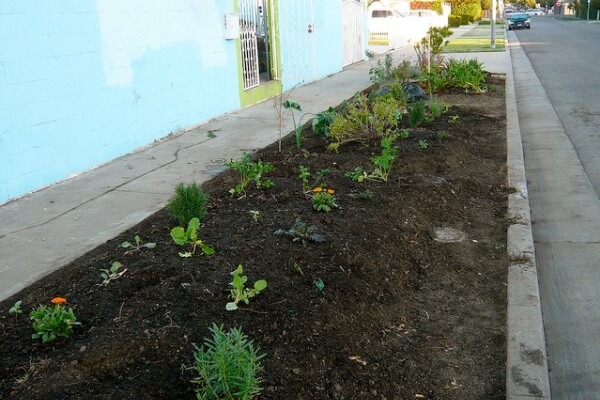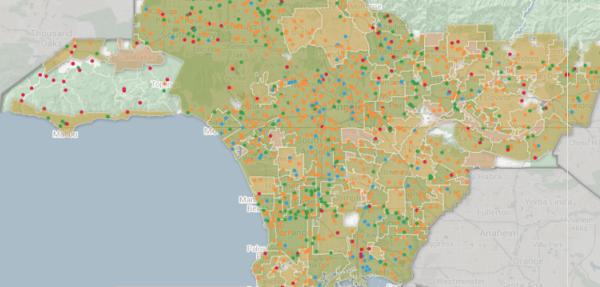Inside L.A's Vast Urban Agricultural Landscape

Here's a fun way to pass an afternoon: Walk out of your place. Begin going in whatever direction you choose, wherever your spirit takes you, for an hour or so. At the end of that time, turn around and take a different route back home. But while you're going on this walk, pay careful attention to how many small pockets of urban agriculture blanket the city. Parkway gardens. Neighborhood nurseries. Schoolyard veggies poking their heads out of carefully maintained planters. If you do it in the afternoon, you might find a farmers' market of some sort. Such is the current ever-expanding landscape of urban agriculture in our fair city.
Problem is, there's no good way to track it all. There's not a map or website out there that compiles the various small pieces of the city's gorgeous public gardens in one place. At least, there wasn't until last month.
Cultivate L.A. is a group of students in the Urban Planning Masters program over at UCLA that has spent the past year tracking down every bit of urban ag in L.A. County for a massive report and, perhaps more importantly, an extensive interactive map. To get some background into the project, I spoke to Rachel Surls, sustainable food systems advisor for UC's Cooperative Extension in L.A. County, and the students' "client" for this specific project.
Where did the idea come from?
Rachel Surls: Urban agriculture is one of the issues I'm working on, and it's kind of a confusing topic because it means different things for different people. For example, some people call their backyard garden an urban farm, other people are actually producing something and selling it at the farmers' market. It involves all of these overlapping municipal codes, and there's a lot of questions around what it looks like, how profitable it is, how much of it is out there in L.A. So to have a study done that would help me understand this topic was just incredibly appealing.
One of the things the students did that was so amazing was they decided to look into the matter of municipal codes that regulate urban agriculture. They contacted all 88 cities -- we have 88 incorporated cities, plus all the unincorporated areas -- and they looked at all these different components to find out if they were allowed in different areas. For example, are bees allowed? Are chickens and other kinds of poultry allowed? Are goats allowed? So that's one of the outcomes of the project I'm very excited about. Let's say you're a homeowner that wants to get into raising chickens. It's a little complicated to know where to look, who to ask. What part of your city's website is it under? Is it under animal control? Is it under noise and nuisance? There's so much complexity to it, and they've really taken it down to a usable form.
Besides finding out what a person's municipality would allow, what other uses does the map provide?
Rachel: One of things it does is allow you to set a radius around a particular location and find out what urban agriculture projects are near. So, maybe you're a parent and want to know what urban projects are in your area, or maybe you're considering starting an urban farm and want to find out if there's other similar businesses in the area. You can use this tool for that.
Were there certain municipalities that stood out as more friendly than others?
Rachel: Yeah, definitely. One of the ones that is not urban agriculture friendly is Beverly Hills. The students came up with fifteen different kinds of agricultural activities that they looked into, and they found that Beverly Hills, specifically, doesn't permit any of the activities. So this is a city that's very restrictive. And Gardena is another that's quite restrictive.
The cities that tend to be the most friendly towards agriculture, I guess it's no surprise, are less dense and have a history of farming. For example, Lancaster and Palmdale. They're very friendly towards agriculture.

(Click the photo to head over to the map.)
Do you want this information to be used to get certain cities to alter their regulations and make them more friendly?
Rachel: My role is to extend information to the public to help them make decisions. That's not a policy or an advocacy role, as much as simply providing research-based information. However, one of the things I hope will come out of this, and I would love to be involved in this, is thinking up the best practices for cities around urban ag policy, helping local urban planners help cities in Los Angeles County address their planning codes to become more consistent and more rational in their approach to urban agriculture. Since it's becoming so popular, cities do need to pay a little bit more attention to it. It would be nice if the definitions and codes could be similar around the county, rather than being so confusing.
Over the past few years, has there been a shift in one direction or another in L.A.?
Rachel: The population of L.A., I would say, has far more people over the last four, five years who are interested in some facet of urban agriculture, whether it's keeping backyard chickens, or keeping bees, or just growing vegetables in their yard. People are very interested in this. So there's been a cultural shift towards wanting urban agriculture and having more opportunities for very small scale food production. But the codes and the policies have not been keeping pace. Hopefully, all the research that's been done by the students will help urban planners and city officials update the policies.